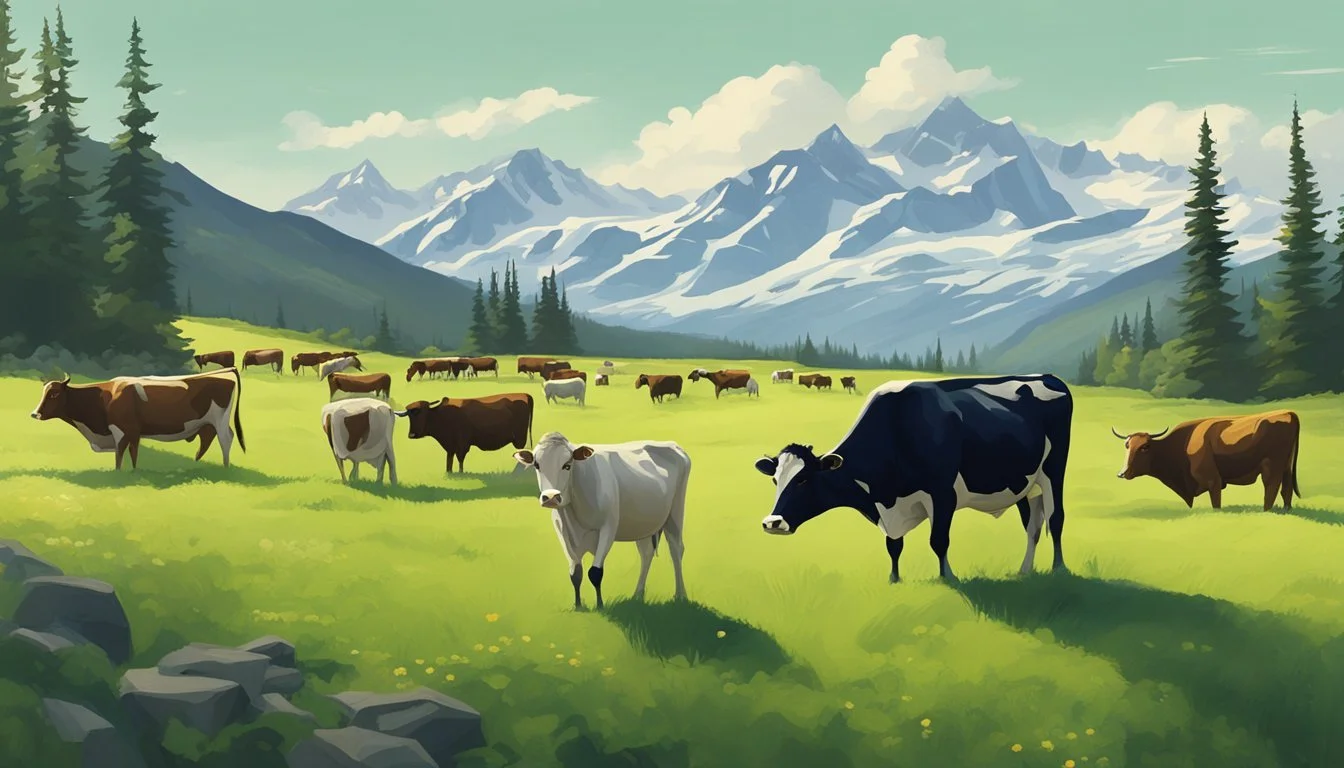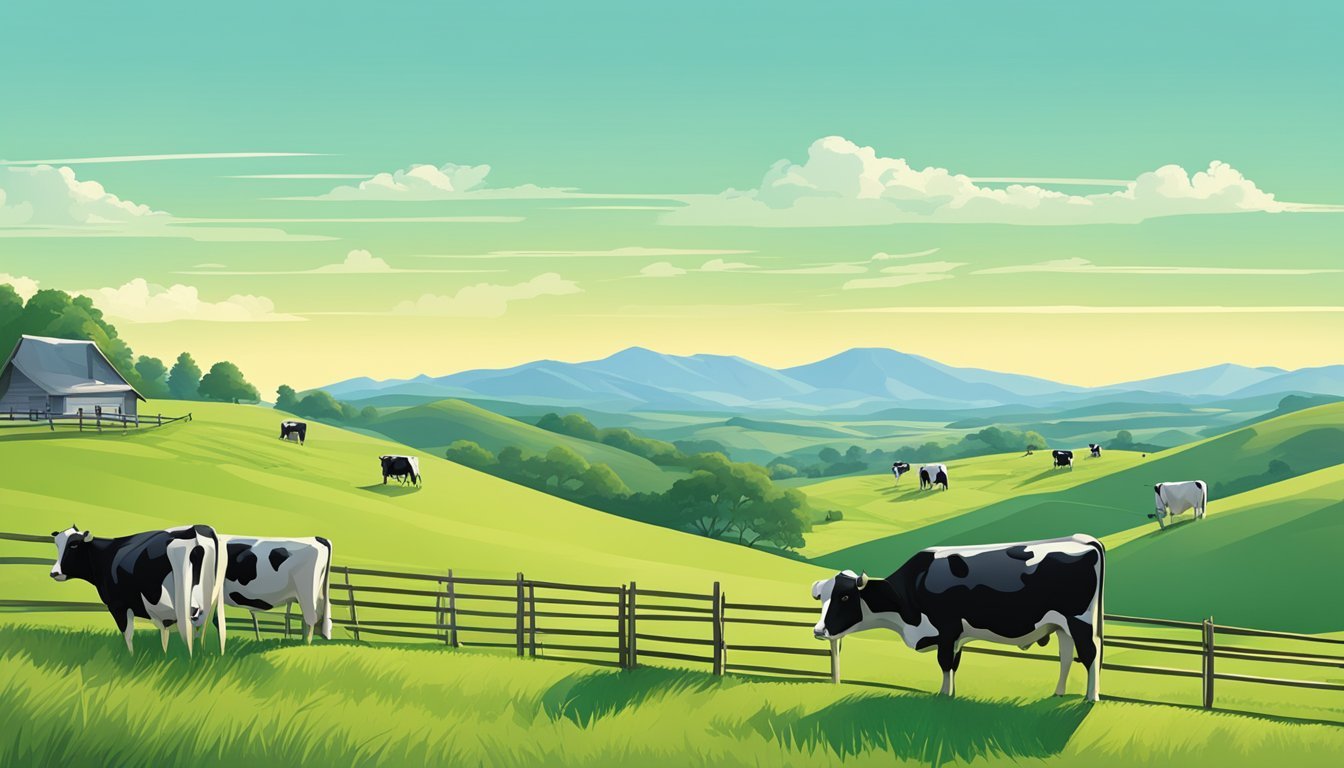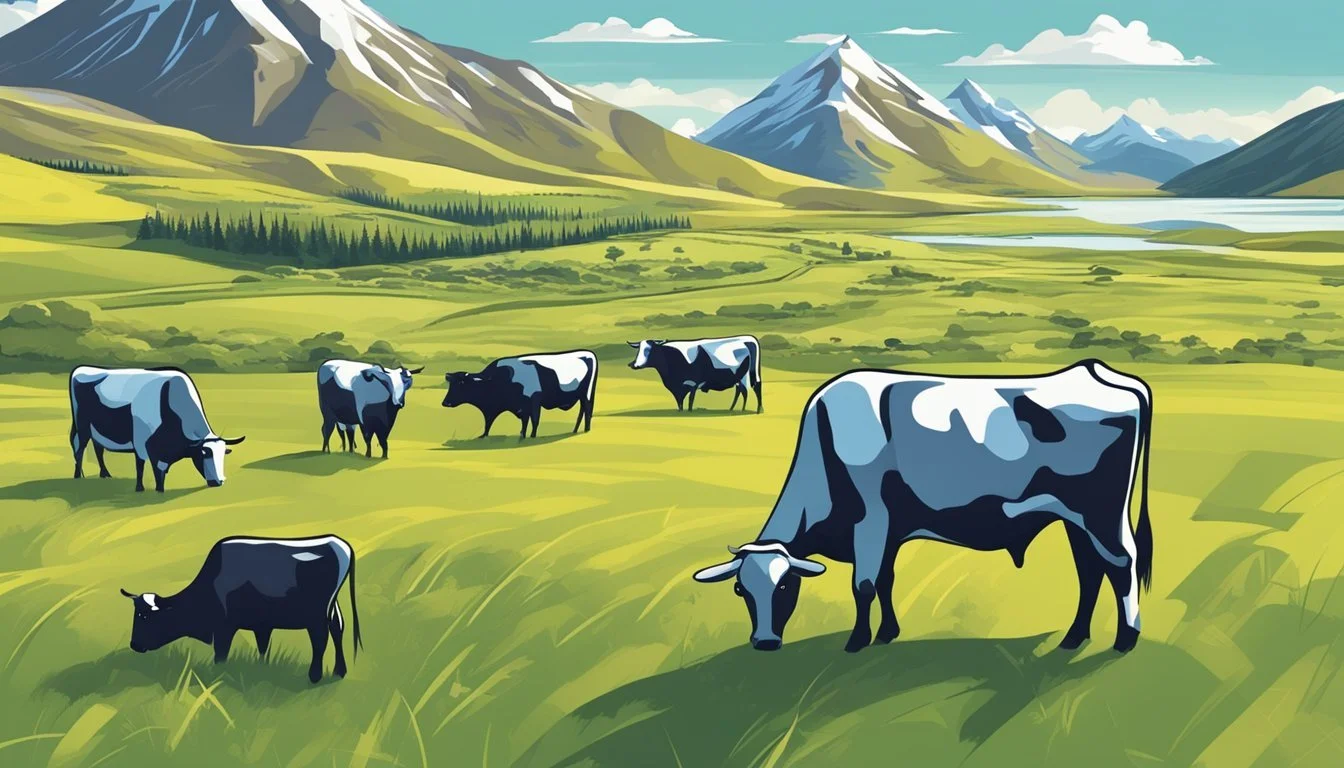Stocking Rate Alaska
Determining Your Land's Cow Capacity per Acre
Determining the appropriate stocking rate for cattle operations is a critical aspect for ranchers aiming for sustainable land management and animal welfare in Alaska. The stocking rate, defined as the number of animals per unit area of land for a specified time period, hinges on various factors including the quality and quantity of forage, land size, and climatic conditions unique to the region. Alaskan cattle producers must navigate the state's diverse and often challenging environments, from the lush, grassy expanses of the Mat-Su Valley to the drier regions of the Interior, to effectively manage their herds in conjunction with the land's carrying capacity.
Establishing a proper stocking rate in Alaska poses distinctive challenges due to the state's broad range of ecosystems. Producers must consider the variability of forage production, not only seasonally but also interannually due to fluctuating weather patterns. Additionally, grazing techniques and pasture management practices must adapt to preserve the fragile Alaskan environment while providing for the nutritional needs of the cattle. By carefully analyzing forage availability and land area, Alaskan ranchers can calculate a stocking rate that supports cattle health and growth without overtaxing natural resources.
Understanding Stocking Rate
Stocking rate is a crucial concept in pasture management, referring to the balance between the number of animals and the available land resource. It is typically expressed as animal units (AUs) per acre. An animal unit is defined as a 1,000-pound cow, and this standard is used to compare different types of cattle or livestock based on forage needs.
For cows per acre in Alaska, it's essential to consider the area's unique carrying capacity due to climate and forage types. A proper stocking density ensures that the cattle have enough food throughout the year without overgrazing.
Stocking Density Factors:
Cattle type: Different breeds and sizes require varying amounts of forage.
Carrying capacity: The maximum number of cattle the land can support sustainably.
Farmers need to calculate the correct head of cattle per acre to maintain a healthy balance. Overstocking risks land degradation and underfeeding, while understocking may result in underutilized resources.
To calculate the stocking rate, one must know:
Total land area (acres)
Available forage amount
Forage utilization percentage
Table 1: Stocking Rate Calculation Example
Factor Example Value Total Land Area 200 acres Number of Animal Units 50 AUs Grazing Season 12 months Resulting Stocking Rate 0.33 AUM or 4 AUY
Note: AUM stands for animal unit month, and AUY for animal unit year.
In conclusion, understanding and accurately determining stocking rate is paramount for sustainable cattle farming in Alaska.
Evaluating Pasture and Land Characteristics
To determine how many cows a property in Alaska can support, one must evaluate the specific conditions of the pasture and land. This assessment is crucial to ensure sustainable stocking rates that prevent overgrazing and maintain soil health.
Assessing Pasture Condition
The condition of the pasture is indicative of its capacity to support livestock. A healthy pasture in Alaska should exhibit a diversity of native grasses and forages suitable for the region's harsh climate. One must check for signs of overgrazing, such as compacted soil or a reduction in desirable plant species, which could lead to soil degradation and reduced productivity.
Analyzing Soil Health and Terrain
Soil health is a cornerstone of pasture sustainability. Ideal soil conditions for a thriving pasture in Alaska include proper pH levels, nutrient content, and drainage capabilities. The terrain also plays a significant role; flat to gently rolling lands support better forage growth and are easier for cattle to graze than steep, hilly areas, which are prone to erosion and may lead to desertification.
Estimating Forage Production
Forage production is directly linked to the acreage available and the health and biodiversity of the pasture. In Alaska, the calculation of forage production must be accurate to ensure the land's carrying capacity is not exceeded. One should measure the biomass of edible plant material and take into account seasonal variations typical to Alaskan weather and climate conditions to estimate the sustainable stocking rates for the land.
Climate Factors Affecting Stocking Rate
In Alaska, the stocking rate for cattle is significantly influenced by climate, particularly through precipitation and forage dynamics. Proper understanding of these factors is crucial for determining sustainable grazing practices.
Precipitation and Seasonal Variations
Alaska's climate presents unique challenges for cattle ranchers, particularly due to its varied precipitation and extended seasonal changes. The state experiences annual precipitation ranging from as little as 10 inches in the Arctic region to over 100 inches in the southeastern rainforests. The majority of this precipitation falls during the summer, which is the primary grazing season.
Interior Alaska: Semi-arid with short, intense summers that can influence forage growth rates.
Southcentral and Southeastern Alaska: High rainfall conducive to lush forage but may lead to soil saturation and reduced grazing areas.
Northern and Western Alaska: Lower precipitation and shorter growing seasons, necessitating a lower stocking rate.
Adaptation to these conditions includes careful monitoring of the grazing land during the peak season and adjusting the stocking rate accordingly. For example, one might allow fewer cattle per acre in drier regions to prevent overgrazing and land degradation.
Effect of Climate on Forage Quality and Yield
Climate not only affects the quantity of forage available but also its quality, which is paramount for maintaining healthy livestock. In areas with higher annual precipitation and milder temperatures, such as the coastal regions of Alaska, forage quality may be higher, supporting a greater stocking rate. The cooler temperatures in many parts of the state can slow forage growth, potentially reducing the nutritional value and yield.
It is important to note that:
Warm, Wet Climates: Support higher forage quality, potentially increasing livestock weight gain and the possible number of cattle per acre.
Cool, Dry Climates: Often result in lower forage quality, decreasing cattle carrying capacity.
Farmers must evaluate the balance between forage quality and yield when assessing the potential stocking rate for their cattle. They may need to supplement cattle diets with additional feed to compensate for lower forage quality, especially during harsher climate conditions or in the aftermath of unseasonal weather patterns.
Grazing Management Strategies
Effective grazing management strategies are crucial to optimize forage utilization while preventing overgrazing. These practices ensure a balance between animal needs and pasture sustainability.
Rotational vs. Continuous Grazing
Rotational Grazing involves dividing the pasture into smaller areas, called paddocks, where livestock graze on one section at a time. This allows for periods of rest and regrowth for grazed areas, which can lead to improved forage production and distribution. With strategic planning, rotational grazing can support a higher stocking density compared to continuous grazing.
In contrast, Continuous Grazing allows livestock to graze on the entire pasture for an extended period. This can result in uneven forage utilization, with some areas being overgrazed while others are underutilized. While continuous grazing requires less initial management, it often leads to lower overall pasture productivity.
Forage Utilization and Grazing Distribution
For optimal Forage Utilization, managing grazing intensity and duration is key. Grazing too short can reduce plant recovery, while grazing too long can diminish root reserves. Achieving a utilization rate that does not exceed 50% of the forage is considered sustainable, allowing for plant recovery and sustained production.
Grazing Distribution within a pasture is influenced by terrain, water sources, and forage quality. Improving distribution can be achieved through strategic placement of salt and mineral feeders, water sources, and by creating physical barriers. This ensures that animals use the entire pasture more evenly, enhancing the overall grazing practices.
Adjusting Stocking Rate to Avoid Overgrazing
The Stocking Rate dictates how many animals the land can support throughout the grazing season. Overstocking can lead to overgrazing, reduced forage availability, and soil degradation. It is essential to monitor forage growth and adjust livestock numbers accordingly. Stocking rates in Alaska may fluctuate based on factors such as soil fertility, forage species, and weather patterns.
Adapting the stocking rate is part of responsible grazing management. It enables the land to sustain animal nutrition and health, and maintain ecological balance. Flexibility in management practices is particularly important to accommodate the variable conditions often encountered in Alaskan grazing environments.
Enhancing Pasture Productivity
To effectively support livestock, optimizing pasture productivity is crucial. Strategic supplementation and management techniques can boost both forage yield and quality.
Supplements and Forage Improvement
Supplements can play a key role in improving pasture forage yield. Appropriate supplements ensure that grasses have the necessary nutrients to flourish, particularly in the challenging Alaskan climate. For instance, soils low in nitrogen can benefit from the application of nitrogen-rich fertilizers, which in turn can enhance the monthly production of forage. One must keep in mind the balance of fertilization to prevent over-enrichment, which can lead to environmental issues and diminished pasture health.
Types of Supplements:
Nitrogen fertilizers: Increase grass growth and forage yield.
Phosphate fertilizers: Essential for root development and plant maturation.
Potassium fertilizers: Improve forage quality and resistance to disease and drought.
Managing Paddocks and Fencing
Implementing a paddock system with proper fencing can lead to more efficient grazing patterns and allow pastures to recover between grazing periods. Dividing larger pastures into smaller, more manageable paddocks enforces systematic rotation, which sustains grass productivity and prevents overgrazing.
Paddock Rotation Benefits:
Enhanced forage growth: Regular rotations allow grass to rest and regrow.
Weed control: Grazing management can reduce weed proliferation.
Soil health: Prevents soil compaction and preserves pasture structure.
In conclusion, the art of maximizing pasture productivity in Alaska through supplements and effective paddock management can lead to sustained forage yield, benefiting both the land and the livestock. Proper implementation of these practices is not just beneficial for the current season but is essential for long-term pasture health and productivity.
Calculating Animal Units and AUM
When ranchers in Alaska consider livestock stocking rates, they rely on the concepts of Animal Units (AUs) and Animal Unit Months (AUMs). These are standard measures used to compare the foraging needs of different types and sizes of cattle, as well as to assess pasture land's capacity to sustain these animals.
Animal Units (AUs) designate a standard based on a 1000 lb cow, which is set to 1 AU. Other cattle are then calculated relative to this benchmark. For instance:
A 1200 lb cow would be 1.2 AUs
A 600 lb calf would be 0.6 AUs
An Animal Unit Month (AUM) is the amount of forage required by one AU for one month. It is a crucial figure that helps determine the number of cattle that can graze on a pasture without degrading the land.
Here's a simplified overview:
Weight of Cattle Animal Units (AU) 1000 lbs 1 AU 1200 lbs 1.2 AUs 600 lbs 0.6 AUs
To calculate the carrying capacity of a property, ranchers must consider the total AUMs available from their land and compare that to the AUM requirements of their herd. Acres per cow will vary based on the quality of pasture and climatic conditions.
Alaska's rugged terrain and harsh weather conditions make local knowledge crucial, so it is advised that ranchers consult with local agricultural extension offices to obtain region-specific forage rates and grazing period recommendations.
Sustainability and Environmental Considerations
In Alaska, the balance between livestock production and the preservation of the environment is crucial. Sustainability hinges on maintaining biodiversity and soil health, while preventing desertification through responsible pastoral practices.
Promoting Biodiversity and Preventing Soil Degradation
Biodiversity is the variety of life in a particular ecosystem. In Alaska's pastures, this encompasses a range of plants, insects, and microbial life that form a web of ecological interaction. Maintaining this diversity is critical as it contributes to the resilience of the ecosystem and aids in the prevention of soil degradation. Overgrazing leads to a loss in plant species, which can result in soil erosion and a decline in soil fertility. By managing stocking rates appropriately, ranchers can ensure:
Sufficient ground cover to protect soil from erosion
Preservation of a mix of plant species crucial to soil health
Suitable habitats for wildlife, enhancing ecological sustainability
Pasture Recovery and Avoiding Desertification
Pasture recovery time is essential in avoiding desertification, a form of land degradation where fertile land becomes arid and unable to support diverse agricultural use. In the colder Alaskan climate, the growth and recovery of pasture can be slow; thus, overgrazing can have lasting impacts. Avoiding desertification involves:
Rotational grazing to allow pasture to recover
Monitoring of pasture condition to ensure it can support grazing
Adoption of practices that retain moisture and nutrients in the soil
By strictly adhering to these methods, ranchers can contribute to environmental sustainability and prevent the long-term loss of productive land.
Operational Aspects of Cattle Farming in Alaska
Cattle farming in Alaska has unique operational aspects due to its climate and geographical conditions. Successful ranching relies on diligent tracking and comprehensive economic analysis to ensure profitability and maintain cattle health.
Tracking and Record Keeping
Ranchers in Alaska must maintain meticulous records to monitor cattle health and forage availability. They utilize digital databases or traditional ledger books to log:
Livestock Inventory: Detailed counts of cattle and other livestock species.
Milk Production: Measurements and trends in output if dairy operations are present.
Crops: Records on planted and harvested crops, yields, and production used for grazing or as feed.
Alaska's tough winters demand careful tracking of feed reserves, ensuring livestock sustenance when natural forage is scarce.
Economic Analysis and Profitability
Economic analysis in Alaskan cattle farming involves:
Profitability Assessments: Comparing total revenue from cattle operations against input costs such as feed, labor, and veterinary care.
Market Trends: Analysis of local and national market trends for beef prices, which significantly influence revenue streams.
Ranchers adjust their stocking rates accordingly, aiming to match the carrying capacity of their land with the number of livestock it can sustain without environmental degradation. Profitable cattle farming hinges on the rancher's ability to balance between operational costs and income generated from cattle sales and by-products.
Custom Options for Diverse Properties
When determining the appropriate stocking rate for cows in Alaska, property owners must recognize the need for custom options. The varying topography and climate can significantly impact forage availability and, consequently, the number of cows that can comfortably survive on an acre. For instance, an acre in the lush Matanuska Valley may support more cows than an acre in the more arid regions of the Interior.
Customized options might include rotational grazing, which involves dividing the pasture into smaller areas and moving the cattle between them. This practice allows vegetation in the unused sections to recover and maintain nutritional value.
Table 1: Grazing method vs. Forage Efficiency
Grazing Method Expected Forage Efficiency Continuous Moderate Rotational High
Incorporating other livestock such as chickens can complement cows by promoting soil health and reducing pests, potentially improving the carrying capacity for the cows. Chickens provide additional benefits without necessarily competing for the same resources.
Property owners should also consider the use of ads to connect with experts who offer personalized consultations. These professionals can visit the property, assess the specific conditions, and develop a tailored grazing plan. This service can optimize the use of land, ensuring a balance between productivity and sustainability.
Utilizing these custom options allows cattle owners in Alaska to responsibly manage their herds and land, ensuring their operations thrive in diverse conditions.







